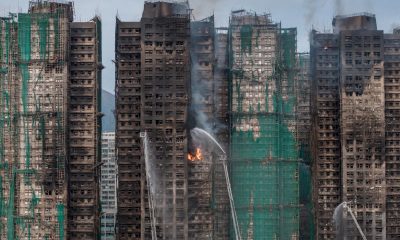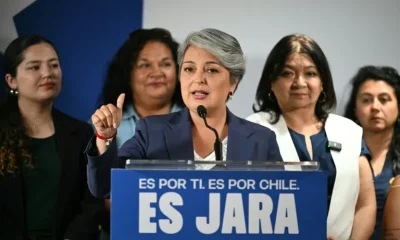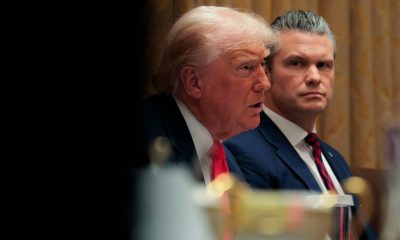International
Bolivia president vows to punish ‘coup’ accused

AFP
Bolivia President Luis Arce vowed in a lively parliamentary session Friday to work tirelessly to punish those accused by the government of an alleged coup in 2019, when former leader Evo Morales lost power.
“We won’t cease… to demand the processing and punishment of those responsible for the coup d’etat,” said Arce during an event to mark the founding of Bolivia on August 6, 1825.
He also claimed there were “international accomplices.”
Leftist Morales resigned as president in November 2019 after weeks of protests against his re-election to an unconstitutional fourth term.
The then-leader of the Movement for Socialism party that has dominated Bolivian politics for more than 15 years, quit after losing the support of the military following an Organization of American States (OAS) audit that found clear evidence of fraud in his re-election.
Conservative Jeanine Anez assumed the interim presidency, as she was the highest ranking government official not to have resigned.
She retained that role until new elections, which had been twice postponed due to the coronavirus pandemic, were organized a year later.
– ‘Illegitimate and violent acts’ –
Those who provoked the fall of Morales, “must respond to the courts for the illegal, illegitimate and violent acts perpetrated against the people, democracy and the political constitution of the state,” said Arce, who also represents MAS.
He was referring to clashes between MAS supporters and security forces following the resignation of Morales.
Thirty-five people have died in total in clashes between MAS supporters and opponents following the 2019 election.
Centrist former president Carlos Mesa hit out at Arce on social media for pandering to Morales “and his obsession to seek power at any cost.”
In February, the MAS-dominated congress gave political amnesty to those prosecuted for acts of violence in the chaos that followed the election.
Anez and several of her interim ministers, as well as ex-military and police chiefs, have been detained since March, as the government seeks to have them prosecuted for the alleged coup.
Just before her arrest, Anez tweeted: “The political persecution has begun.”
The government claims regional right-wing allies of Anez, such as Ecuador’s then-president Lenin Moreno (2017-2021) and Mauricio Macri (2015-2019) of Argentina, had sent weapons to Bolivia.
They also claim the European Union, Catholic Church and former Bolivian presidents Mesa (2003-2005) and conservative Jorge Quiroga (2001-2002) were part of a conspiracy to oust Morales and replace him with Anez.
The EU has rejected the accusation.
Anez, a former senator, only took power because the vice-president and presidents of both houses of congress — all MAS party members — had also resigned.
The parliamentary session on Friday was interrupted several times by rival politicians shouting at each other.
The day before had seen fresh clashes between government supporters and opponents in La Paz.
International
El Chapo’s son Joaquín Guzmán López pleads guilty to U.S. drug trafficking charges

Joaquín Guzmán López, one of the sons of notorious Mexican drug lord Joaquín “El Chapo” Guzmán, pleaded guilty on Monday to drug trafficking charges in a U.S. court, months after his brother Ovidio reached a similar plea agreement, according to local media reports.
The defendant appeared before a federal court in Chicago early Monday afternoon and changed his previous plea in the case, the Chicago Tribune reported. U.S. authorities accuse him of forming, together with his three brothers, the cartel faction known as “Los Chapitos.”
The group is believed to have continued the operations of El Chapo, who has been serving a life sentence in the United States since 2019.
Guzmán López, 39, was arrested after landing in Texas in a small aircraft alongside cartel co-founder Ismael “El Mayo” Zambada.
International
Venezuela authorizes return flights as U.S. continues deportations amid rising tensions

The arrival of U.S. aircraft carrying undocumented Venezuelan migrants continued regularly despite rising tensions between Washington and Caracas over President Donald Trump’s military deployment in the Caribbean.
Trump maintains that the deployment is part of an anti-narcotics operation, while Venezuelan President Nicolás Maduro insists the true objective is to remove him from power and seize the nation’s oil resources.
Venezuela’s aviation authority has “received a request from the United States government to resume repatriation flights for Venezuelan migrants from that country to Venezuela,” the Ministry of Transportation said in a statement .
“Under the instructions of President Nicolás Maduro, authorization has been granted for these aircraft to enter our airspace,” it added.
Caracas will permit two Eastern Airlines flights to land on Wednesday and Friday.
Migration remains one of the Trump administration’s flagship issues. On Monday, the U.S. president held a meeting with his National Security Council to discuss the situation in Venezuela, a day after confirming he had spoken with Maduro by phone, without offering further details.
According to the Venezuelan government, roughly 75 deportation flights have been carried out this year, returning at least 13,956 Venezuelans from the United States.
International
20,000 rounds stolen from german army after driver leaves cargo unattended

The German army confirmed the theft of a shipment of ammunition that occurred a week ago while it was being transported by a civilian delivery driver, a military spokesperson told AFP, confirming earlier media reports.
According to Der Spiegel and the regional broadcaster MDR, around 20,000 rounds of ammunition were stolen from an unguarded parking lot near Magdeburg, in eastern Germany, while the driver was asleep in a nearby hotel. No information has been released regarding the identity of the suspects, and the military declined to specify the exact type or amount of ammunition taken.
Authorities have also not indicated how the perpetrators knew the cargo would be left unattended.
“The theft was discovered upon delivery at the barracks,” the German army spokesperson said.
A police spokeswoman confirmed to AFP that an investigation has been opened but refused to provide further details “for tactical reasons.”
Sources close to the German military, cited by Der Spiegel, believe it is unlikely the theft was a coincidence. They suspect the thieves waited for the driver to stop for the night before striking.
Der Spiegel also reported that the Defense Ministry normally requires two drivers for this type of transport to ensure the cargo is constantly monitored. However, in this case only one driver was assigned, meaning the civilian transport company failed to comply with the security protocols.
-

 Central America4 days ago
Central America4 days agoTrump Pardons Former Honduran President Hernández and Warns of Aid Cuts Ahead of Election
-

 Central America2 days ago
Central America2 days agoHonduras Extends Voting by One Hour Amid High Turnout, CNE Announces
-

 International1 day ago
International1 day agoHong Kong police arrest 13 over deadly high-rise fire that killed 151
-

 Central America3 days ago
Central America3 days agoHonduras’ China–Taiwan Future Hinges on Sunday’s Presidential Election
-

 International4 days ago
International4 days agoMeta Says Russia Seeks to Ban WhatsApp for Defending Secure Communication
-

 International1 day ago
International1 day agoSri Lanka and Indonesia deploy military as deadly asian floods kill over 1,000
-

 International1 day ago
International1 day agoTrump says asylum decision freeze will remain in place “for a long time”
-

 International1 day ago
International1 day agoChile enters runoff campaign with Kast leading and Jara seeking a last-minute comeback
-

 International3 hours ago
International3 hours agoVenezuela authorizes return flights as U.S. continues deportations amid rising tensions
-

 International3 hours ago
International3 hours agoEl Chapo’s son Joaquín Guzmán López pleads guilty to U.S. drug trafficking charges
-

 International3 hours ago
International3 hours agoTrump convenes National Security Council as U.S.–Venezuela tensions intensify
-

 International3 hours ago
International3 hours ago20,000 rounds stolen from german army after driver leaves cargo unattended






























